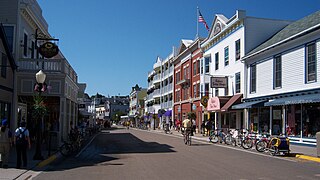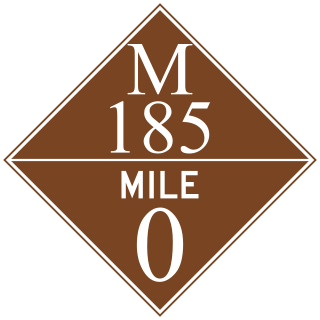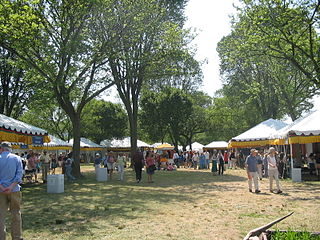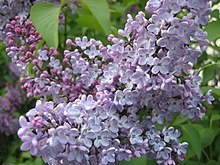
The Mackinac Bridge is a suspension bridge that connects the Upper and Lower peninsulas of the U.S. state of Michigan. It spans the Straits of Mackinac, a body of water connecting Lake Michigan and Lake Huron, two of the Great Lakes. Opened in 1957, the 26,372-foot-long bridge is the world's 27th-longest main span and is the longest suspension bridge between anchorages in the Western Hemisphere. The Mackinac Bridge is part of Interstate 75 (I-75) and carries the Lake Michigan and Huron components of the Great Lakes Circle Tour across the straits; it is also a segment of the U.S. North Country National Scenic Trail. The bridge connects the city of St. Ignace to the north with the village of Mackinaw City to the south.

Mackinac Island is an island and resort area, covering 4.35 square miles (11.3 km2) in land area, in the U.S. state of Michigan. The name of the island in Odawa is Michilimackinac and "Mitchimakinak" in Ojibwemowin, meaning "Great Turtle". It is located in Lake Huron, at the eastern end of the Straits of Mackinac, between the state's Upper and Lower Peninsulas. The island was long home to an Odawa settlement and previous indigenous cultures before European colonization began in the 17th century. It was a strategic center of the fur trade around the Great Lakes. Based on a former trading post, Fort Mackinac was constructed on the island by the British during the American Revolutionary War. It was the site of two battles during the War of 1812 before the northern border was settled and the US gained this island in its territory.

Syringa is a genus of 12 currently recognized species of flowering woody plants in the olive family or Oleaceae called lilacs. These lilacs are native to woodland and scrub from southeastern Europe to eastern Asia, and widely and commonly cultivated in temperate areas elsewhere.

The NAMES Project AIDS Memorial Quilt, often abbreviated to AIDS Memorial Quilt or AIDS Quilt, is a memorial to celebrate the lives of people who have died of AIDS-related causes. Weighing an estimated 54 tons, it is the largest piece of community folk art in the world, as of 2020. It was conceived in 1985, during the early years of the AIDS pandemic, when social stigma prevented many AIDS victims from receiving funerals. It has been displayed on the Mall in Washington, D.C., several times. In 2020, it returned to San Francisco, where it is cared for by the National AIDS Memorial. It can be seen virtually.

Lombard is a village in DuPage County, Illinois, United States, and a suburb of Chicago. The population was 44,476 at the 2020 census.

Henderson is a home rule-class city along the Ohio River and the county seat of Henderson County, Kentucky, United States. The population was 29,781 at the 2020 U.S. census. It is part of the Evansville–Henderson, IN–KY Metropolitan Area, locally known as the "Tri-State Area," and is considered the southernmost suburb of Evansville, Indiana.

Mackinac Island is a city in Mackinac County in the U.S. state of Michigan. As of the 2020 census, the city had a population of 583.

The Rose Parade, also known as the Tournament of Roses Parade, is an annual parade held mostly along Colorado Boulevard in Pasadena, California, United States, on New Year's Day.

Santa Claus parades, also called Christmas parades, are parades held in some countries to celebrate the official opening of the Christmas season with the arrival of Santa Claus who always appears in the last float. The parades usually include themed floats, dancing or marching groups and bands playing Christmas songs. They are moving pageants that typically end near the centre of a city. Often sponsored by department stores, they may reinforce the store's brand recognition during the important Christmas shopping season.

M-185 is a state trunkline highway in the U.S. state of Michigan that circles Mackinac Island, a popular tourist destination on the Lake Huron side of the Straits of Mackinac, along the island's shoreline. A narrow paved road of 8.004 miles (12.881 km), it offers scenic views of the straits that divide the Upper and the Lower peninsulas of Michigan and Lakes Huron and Michigan. It has no connection to any other Michigan state trunkline highways—as it is on an island—and is accessible only by passenger ferry. The City of Mackinac Island, which shares jurisdiction over the island with the Mackinac Island State Park Commission (MISPC), calls the highway Main Street within the built-up area on the island's southeast quadrant, and Lake Shore Road elsewhere. M-185 passes by several important sites within Mackinac Island State Park, including Fort Mackinac, Arch Rock, British Landing, and Devil's Kitchen. Lake Shore Road carries the highway next to the Lake Huron shoreline, running between the water's edge and woodlands outside the downtown area.

Northern Michigan, also known as Northern Lower Michigan, is a region of the U.S. state of Michigan. A popular tourist destination, it is home to several small- to medium-sized cities, extensive state and national forests, lakes and rivers, and a large portion of Great Lakes shoreline. The region has a significant seasonal population much like other regions that depend on tourism as their main industry. Northern Lower Michigan is distinct from the more northerly Upper Peninsula and Isle Royale, which are also located in "northern" Michigan. In the northernmost 21 counties in the Lower Peninsula of Michigan, the total population of the region is 506,658 people.

A float is a decorated platform, either built on a vehicle like a truck or towed behind one, which is a component of many festive parades, such as those of Carnival in Rio de Janeiro, the Carnival in São Paulo, the Carnival of Viareggio, the Maltese Carnival, the Macy's Thanksgiving Day Parade, Mardi Gras in New Orleans, the Gasparilla Pirate Festival, the 500 Festival Parade in Indianapolis, the United States Presidential Inaugural Parade, and the Tournament of Roses Parade. For the latter event, floats are decorated entirely in flowers or other plant material.

The Grand Hotel is an historic hotel and coastal resort on Mackinac Island, Michigan, a small island located at the eastern end of the Straits of Mackinac within Lake Huron between the state's Upper and Lower peninsulas. Constructed in the late 19th century, the facility advertises itself as having the world's largest porch. The Grand Hotel is known for a number of notable visitors, including five U.S. presidents, inventor Thomas Edison, and author Mark Twain.

The culture of San Antonio reflects the history and culture of one of the state's oldest and largest cities straddling the regional and cultural divide between South and Central Texas. Historically, San Antonio culture comes from a blend of Central Texas and South Texas (Southwestern) culture. Founded as a Spanish outpost and the first civil settlement in Texas, San Antonio is heavily influenced by Mexican American culture due to Texas formerly being part of Mexico and, previously, the Spanish Empire. The city also has significant German, Anglo, and African American cultural influences. San Antonio offers a host of cultural institutions, events, restaurants and nightlife in South Texas for both residents and visitors alike.

The Smithsonian Folklife Festival, launched in 1967, is an international exhibition of living cultural heritage presented annually in the summer in Washington, D.C. in the United States. It is held on the National Mall for two weeks around the Fourth of July holiday. The Smithsonian Center for Folklife and Cultural Heritage produces the Festival.

The cuisine of Michigan is part of the broader regional cuisine of the Midwestern United States. It is reflective of the diverse food history of settlement and immigration in the state, and draws its culinary roots most significantly from the cuisines of Central, Northern and Eastern Europe, and Native North America.
The Veterans History Project of the Library of Congress American Folklife Center was created by the United States Congress in 2000 to collect and preserve the firsthand remembrances of U.S. wartime veterans. Its mandate ensures future generations may hear directly from those who served to better understand the realities of war. It is a special project of the American Folklife Center, a research center of the Library of Congress.

Bishop Mule Days is an annual festival celebrating the mule, held in Bishop, California over a six-day period leading up to Memorial Day. More than 700 mules compete in 181 events and the largest non-motorized parade in the United States. It started as a small show in 1969 with a few hundred attendees and has grown to Bishop's largest event, attracting as many as 30,000 spectators. Among mule shows, Bishop Mule Days has been described as "The Granddaddy of Them All".
The culture of Columbus, Ohio, is particularly known for museums, performing arts, sporting events, seasonal fairs and festivals, and architecture of various styles from Greek Revival to modern architecture.

Main Street, U.S.A. is the first "themed land" inside the main entrance of the many theme parks operated or licensed by The Walt Disney Company around the world. Main Street, U.S.A. is themed to resemble American small towns during the early 20th Century. In Tokyo Disneyland, it is called World Bazaar and covered by a glass Victorian-style conservatory roof to shield guests from the weather there. At Shanghai Disneyland, it is called Mickey Avenue and is orientated to help introduce visitors to Disney characters.


















